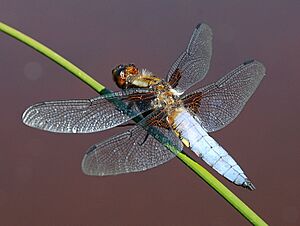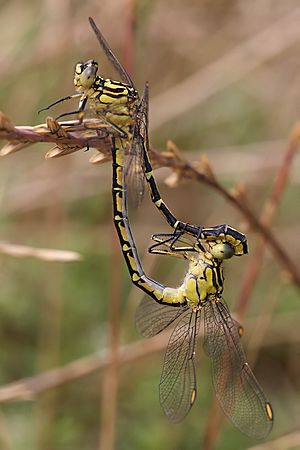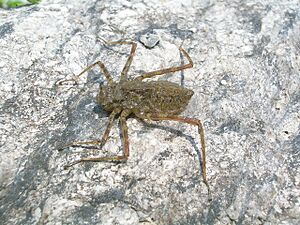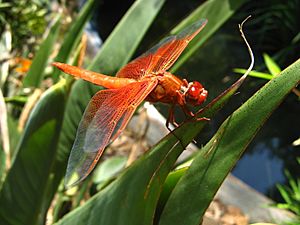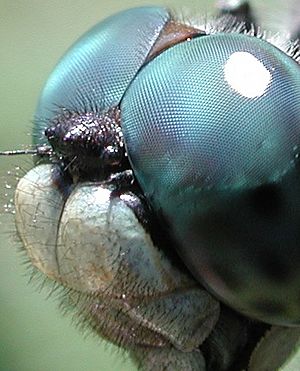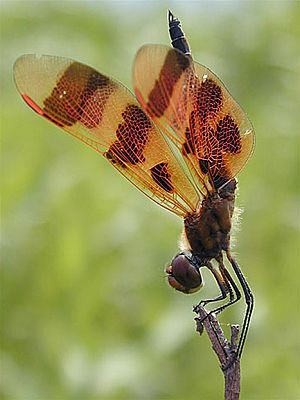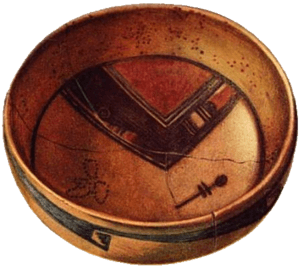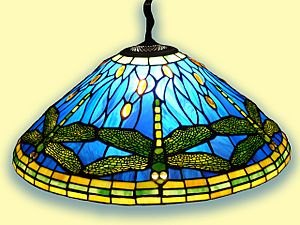Dragonfly facts for kids
Quick facts for kids Dragonfly |
|
|---|---|
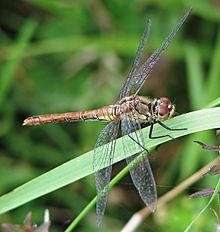 |
|
| Scientific classification | |
| Kingdom: | |
| Phylum: | |
| Class: | |
| Order: | |
| Infraorder: |
Anisoptera
|

Dragonflies are amazing flying insects. They belong to a group called Odonata. There are about 5,300 different kinds, or species, of dragonflies around the world. Adult dragonflies mostly eat other insects that fly.
Dragonflies have very large compound eyes. These eyes are their most important sense. They help them see almost everything around them. Dragonflies also have four strong, clear wings and a long body. Even though they have six legs, like other insects, dragonflies cannot walk.
You can usually find dragonflies near lakes, ponds, streams, and wetlands. They are predators, meaning they hunt and eat other small insects. Their favorite foods include mosquitoes, flies, bees, ants, and even small butterflies. Young dragonflies, called 'nymphs', live in the water.
Dragonflies have been on Earth for a very long time. They have existed for over 300 million years! During the Carboniferous period, some ancient dragonflies had huge wingspans. Their wings could stretch over 2 ft (61 cm) wide.
Contents
Dragonflies and Damselflies: What's the Difference?
Dragonflies and their close relatives, damselflies, are both part of the Odonata group. Many people often confuse them because they look quite similar. However, there are a few easy ways to tell them apart.
Adult damselflies have thinner, more delicate bodies than dragonflies. You can even notice this difference when they are flying. When a damselfly rests, it usually holds its wings together above its body. Most dragonflies, on the other hand, hold their wings out flat and horizontally. Also, dragonflies have larger eyes that often touch each other at the top of their head.
Dragonfly Life Cycle: From Egg to Adult
Laying Eggs
Female dragonflies lay their eggs in or near water. They often place them on plants. Some species even go underwater to lay their eggs on a good surface. These eggs then hatch into tiny young dragonflies called nymphs.
The Nymph Stage
Most of a dragonfly's life is spent as a nymph, living underwater. Nymphs are very active hunters. They eat mosquito larvae and other small creatures. They can even extend their jaws out from their mouth to catch prey. Sometimes, they eat tiny vertebrates like tadpoles and small fish. Some nymphs can even hunt on land!
Nymphs breathe using gills located in their rectum. They can also move very fast by squirting water out of their anus. This jet of water pushes them forward quickly.
The nymph stage can last a long time. For large dragonflies, it might be as long as five years. For smaller species, it can be between two months and three years.
Becoming an Adult
When a nymph is ready to become an adult, it climbs out of the water. It usually finds a reed or another plant sticking up. Once it is exposed to the air, the nymph starts to breathe air. Its skin then splits open at a weak spot behind its head. The adult dragonfly slowly crawls out of its old skin, which is called an exuvia.
After crawling out, the new adult dragonfly pumps up its wings. They are soft at first but quickly harden. Once its wings are ready, the dragonfly flies off to find food. Adult dragonflies of larger species can live for about five or six months.
Dragonflies go through what is called incomplete metamorphosis. This means their young (nymphs) look somewhat like smaller versions of the adults, but they live underwater. The female lays her eggs in or near the water. The nymphs hatch and immediately live in the water.
While underwater, nymphs eat many aquatic insects. They also prey on small creatures like tadpoles and minnows. A nymph will hide among plants, waiting for prey to swim by. When it sees something, it can squeeze water out of its abdomen like a jet stream. This moves the nymph forward very quickly. It then grabs its prey with its powerful jaws. Some nymphs even have a long lower jaw that can shoot out to catch prey!
Naiads (another name for nymphs) live in the water for weeks or even years. They grow by shedding their skin many times. When a naiad is ready for its final shed, it crawls out of the water onto a stick or plant. It waits for its exoskeleton (outer skin) to dry. As the exoskeleton cracks open, the adult dragonfly emerges.
Amazing Adult Dragonflies
Incredible Eyesight
Dragonflies have truly amazing eyesight. Their compound eyes are huge and can have up to 50,000 tiny lenses. These eyes wrap around the top of their head. This gives them a very wide view, allowing them to see almost everywhere at once! Sight is their most important sense. They use it to catch flies and to avoid being caught by birds.
How Dragonflies Fly
Adult dragonflies are incredible flyers. They can move in six directions: up, down, forward, backward, and side to side. They can also hover perfectly still in the air. When they decide to move, they can take off at speeds up to 35 mph (56 km/h).
Scientists have found that dragonflies can move each of their four wings independently. This is what gives them their amazing flying skills. Dragonflies can bend and twist their wings to create small whirlwinds. These whirlwinds make the air move even faster over their wings. This reduces air pressure and gives them a lot of lift, even in strong winds.
Different types of dragonflies have unique flying styles. Here are a few examples:
- Hawkers (family Aeshnidae): These are some of the largest and fastest dragonflies. They spend most of their adult lives flying, even mating in the air. They have powerful wings and can fly forwards, backwards, or hover like a helicopter. Their wings are always held out horizontally.
- Skimmers or Perchers (family Libellulidae): This is a very large family with many different flying styles. For example, the Sympetrum genus lives in the northern hemisphere and has 50 species. They breed in ponds and hunt over meadows.
- Cruisers (family Macromiidae): These dragonflies usually fly straight down the middle of bodies of water (and roads). They have green eyes that just barely meet at the top of their head. Female cruisers do not have a special organ for laying eggs. Instead, they lay their eggs by dipping their abdomen into the water as they fly over.
Staying Cool: Thermoregulation
Some dragonflies change their resting position to avoid getting too hot. On sunny days, they might do a handstand-like pose. They raise their abdomen until its tip points at the sun. This minimizes the part of their body exposed to the heat. This position is called the obelisk posture. Dragonflies that do this are often called 'perchers'. They are "sit and wait" predators who spend a lot of time staying still.
Dragonflies in Culture
Dragonflies have been important in many cultures around the world.
An ancient Egyptian dragonfly amulet made of blue glazed faience was found. It dates back to the Late Middle Kingdom.
For some Native American tribes, dragonflies represent speed and activity. For the Navajo, they symbolize pure water. They are a common design on Zuni pottery. You can also see them in Hopi rock art and on Pueblo necklaces. Dragonflies have been used in traditional medicine in Japan and China. In Indonesia, adult dragonflies are caught on sticky poles, then fried in oil as a special food.
In the United States, studying dragonflies and damselflies has become a popular hobby. It's similar to birdwatching or butterfly watching. This hobby is called "oding," from Odonata, the scientific name for dragonflies. Oding is especially popular in Texas, where 225 different species have been seen. With care and dry fingers, people who "ode" can sometimes gently hold and release dragonflies, though it's not always encouraged.

Dragonfly images are often seen in Art Nouveau designs, especially in jewelry. They have also been used as decorations on fabrics and home items. A British motorcycle company named Douglas even named one of its motorcycle models the Dragonfly.
One of the classical names of Japan is Akitsushima. Akitu or akidu are old Japanese words for dragonfly. So, one meaning of Akitsushima is "Dragonfly Island." This comes from a legend where Japan's mythical founder, Emperor Jinmu, was bitten by a mosquito. Then, a dragonfly ate the mosquito.
In Japan, the dragonfly is a seasonal symbol linked to autumn. More generally, dragonflies symbolize courage, strength, and happiness. They often appear in art and literature, especially in short poems called haiku. Japanese children sometimes play a game where they catch large dragonflies. They use a hair with a small pebble tied to each end. They throw it into the air, and the dragonfly mistakes the pebbles for prey. It gets tangled in the hair and is pulled to the ground by the weight.
In Europe, dragonflies have sometimes been seen as scary or bad. Some English names for them, like "horse-stinger," "devil's darning needle," and "ear cutter," connect them with harm. Swedish folklore says that the devil uses dragonflies to weigh people's souls. The Norwegian name for dragonflies is Øyenstikker, meaning "eye-poker." In Portugal, they are sometimes called tira-olhos, which means "eyes-snatcher." They are often linked to snakes, like in the Welsh name gwas-y-neidr, meaning "adder's servant." In the Southern United States, the term "snake doctor" comes from a folk belief that dragonflies follow snakes and stitch them back together if they are hurt.
Related Pages
Images for kids
-
The giant Upper Carboniferous dragonfly relative, Meganeura monyi, had a wingspan around 680 mm (27 in). Museum of Toulouse
-
Mesurupetala, a dragonfly from the Late Jurassic (Tithonian) period, found in Solnhofen limestone, Germany
-
A group of globe skimmers, Pantala flavescens, during their migration
-
Migrant hawker, Aeshna mixta, showing the long, slender abdomen typical of aeshnid dragonflies.
-
Iridescent structural colouration in a dragonfly's eyes
-
Male green darner, Anax junius has a non-iridescent structural blue color; the female (below) does not have this color.
-
Habitat preference: A four-spotted chaser, Libellula quadrimaculata on an emergent plant, the water violet Hottonia palustris, with submerged plants in the background
-
Nymph of an emperor dragonfly, Anax imperator
-
Ecdysis: An Emperor dragonfly, Anax imperator, newly emerged and still soft, holding on to its dry exuvia, and expanding its wings
-
Red-veined darters (Sympetrum fonscolombii) flying "in cop" (male ahead)
-
Southern hawker, Aeshna cyanea: its wings at this instant are synchronised for agile flight.
-
Accurately drawn dragonflies by Moses Harris, 1780: At top left, the brown hawker, Aeshna grandis (described by Linnaeus, 1758); the nymph at lower left is shown with the "mask" extended.
-
Woodcut on paper, after Kitagawa Utamaro, 1788
See also
 In Spanish: Anisoptera para niños
In Spanish: Anisoptera para niños


